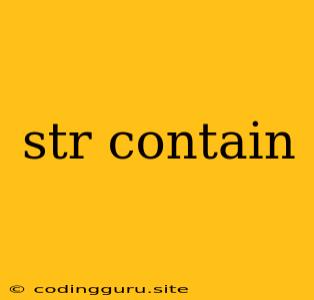Determining if a String Contains a Substring: A Comprehensive Guide
In the world of programming, strings are fundamental data structures used to represent text. One common task is to determine whether a given string contains a specific substring. This article explores various techniques for achieving this, providing insights into their efficiency and applicability.
Understanding the Problem
Let's imagine you have a string, say "Hello World!". You want to know if it contains the substring "World". How do you approach this?
Methods for String Containment
Several approaches can be employed to check for substring existence within a larger string. Let's delve into some of the most popular techniques:
1. Using the in operator:
Python offers an elegant and concise way to check for string containment using the in operator. This approach is both simple and efficient.
string = "Hello World!"
substring = "World"
if substring in string:
print("The string contains the substring.")
else:
print("The string does not contain the substring.")
2. String methods:
Many programming languages provide built-in string methods that simplify the substring containment check. For example, Python's find() and index() methods can be used to locate the substring within the original string.
string = "Hello World!"
substring = "World"
# Using find()
index = string.find(substring)
if index != -1:
print("The string contains the substring at index:", index)
else:
print("The string does not contain the substring.")
# Using index()
try:
index = string.index(substring)
print("The string contains the substring at index:", index)
except ValueError:
print("The string does not contain the substring.")
3. Regular Expressions:
Regular expressions, known for their power in pattern matching, can also be used to determine string containment. However, they are generally more complex and computationally intensive than the previous methods.
import re
string = "Hello World!"
substring = "World"
match = re.search(substring, string)
if match:
print("The string contains the substring.")
else:
print("The string does not contain the substring.")
4. Manual Iteration:
A less efficient but conceptually simple approach involves manually iterating through the string and comparing it with the substring.
string = "Hello World!"
substring = "World"
found = False
for i in range(len(string) - len(substring) + 1):
if string[i:i + len(substring)] == substring:
found = True
break
if found:
print("The string contains the substring.")
else:
print("The string does not contain the substring.")
Factors to Consider
Choosing the optimal approach depends on several factors:
- Language: Different programming languages offer varying built-in methods and libraries.
- Efficiency: The speed and resource consumption of each method can vary.
- Complexity: The complexity of the problem and the desired level of sophistication.
- Clarity: The readability and maintainability of the code.
Conclusion
Determining string containment is a common programming task. Choosing the most suitable approach depends on the specific context and requirements. While the in operator and built-in string methods often provide concise and efficient solutions, regular expressions offer more complex pattern matching capabilities. Understanding the trade-offs involved enables developers to select the most effective method for their needs.
